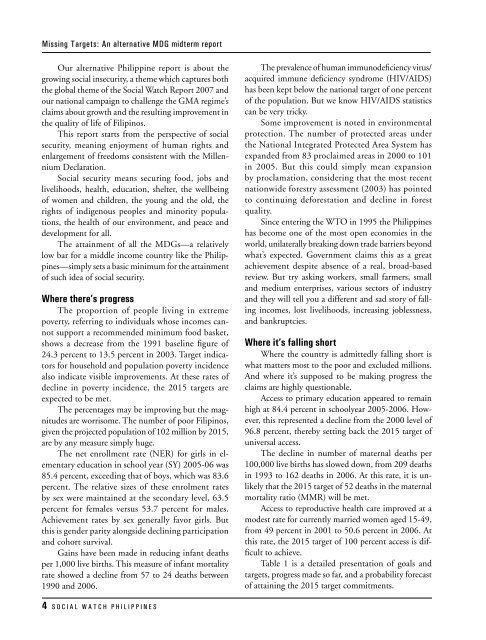one big file - Social Watch
one big file - Social Watch
one big file - Social Watch
Create successful ePaper yourself
Turn your PDF publications into a flip-book with our unique Google optimized e-Paper software.
Missing Targets: An alternative MDG midterm report<br />
Our alternative Philippine report is about the<br />
growing social insecurity, a theme which captures both<br />
the global theme of the <strong>Social</strong> <strong>Watch</strong> Report 2007 and<br />
our national campaign to challenge the GMA regime’s<br />
claims about growth and the resulting improvement in<br />
the quality of life of Filipinos.<br />
This report starts from the perspective of social<br />
security, meaning enjoyment of human rights and<br />
enlargement of freedoms consistent with the Millennium<br />
Declaration.<br />
<strong>Social</strong> security means securing food, jobs and<br />
livelihoods, health, education, shelter, the wellbeing<br />
of women and children, the young and the old, the<br />
rights of indigenous peoples and minority populations,<br />
the health of our environment, and peace and<br />
development for all.<br />
The attainment of all the MDGs—a relatively<br />
low bar for a middle income country like the Philippines—simply<br />
sets a basic minimum for the attainment<br />
of such idea of social security.<br />
Where there’s progress<br />
The proportion of people living in extreme<br />
poverty, referring to individuals whose incomes cannot<br />
support a recommended minimum food basket,<br />
shows a decrease from the 1991 baseline figure of<br />
24.3 percent to 13.5 percent in 2003. Target indicators<br />
for household and population poverty incidence<br />
also indicate visible improvements. At these rates of<br />
decline in poverty incidence, the 2015 targets are<br />
expected to be met.<br />
The percentages may be improving but the magnitudes<br />
are worrisome. The number of poor Filipinos,<br />
given the projected population of 102 million by 2015,<br />
are by any measure simply huge.<br />
The net enrollment rate (NER) for girls in elementary<br />
education in school year (SY) 2005-06 was<br />
85.4 percent, exceeding that of boys, which was 83.6<br />
percent. The relative sizes of these enrolment rates<br />
by sex were maintained at the secondary level, 63.5<br />
percent for females versus 53.7 percent for males.<br />
Achievement rates by sex generally favor girls. But<br />
this is gender parity alongside declining participation<br />
and cohort survival.<br />
Gains have been made in reducing infant deaths<br />
per 1,000 live births. This measure of infant mortality<br />
rate showed a decline from 57 to 24 deaths between<br />
1990 and 2006.<br />
The prevalence of human immunodeficiency virus/<br />
acquired immune deficiency syndrome (HIV/AIDS)<br />
has been kept below the national target of <strong>one</strong> percent<br />
of the population. But we know HIV/AIDS statistics<br />
can be very tricky.<br />
Some improvement is noted in environmental<br />
protection. The number of protected areas under<br />
the National Integrated Protected Area System has<br />
expanded from 83 proclaimed areas in 2000 to 101<br />
in 2005. But this could simply mean expansion<br />
by proclamation, considering that the most recent<br />
nationwide forestry assessment (2003) has pointed<br />
to continuing deforestation and decline in forest<br />
quality.<br />
Since entering the WTO in 1995 the Philippines<br />
has become <strong>one</strong> of the most open economies in the<br />
world, unilaterally breaking down trade barriers beyond<br />
what’s expected. Government claims this as a great<br />
achievement despite absence of a real, broad-based<br />
review. But try asking workers, small farmers, small<br />
and medium enterprises, various sectors of industry<br />
and they will tell you a different and sad story of falling<br />
incomes, lost livelihoods, increasing joblessness,<br />
and bankruptcies.<br />
Where it’s falling short<br />
Where the country is admittedly falling short is<br />
what matters most to the poor and excluded millions.<br />
And where it’s supposed to be making progress the<br />
claims are highly questionable.<br />
Access to primary education appeared to remain<br />
high at 84.4 percent in schoolyear 2005-2006. However,<br />
this represented a decline from the 2000 level of<br />
96.8 percent, thereby setting back the 2015 target of<br />
universal access.<br />
The decline in number of maternal deaths per<br />
100,000 live births has slowed down, from 209 deaths<br />
in 1993 to 162 deaths in 2006. At this rate, it is unlikely<br />
that the 2015 target of 52 deaths in the maternal<br />
mortality ratio (MMR) will be met.<br />
Access to reproductive health care improved at a<br />
modest rate for currently married women aged 15-49,<br />
from 49 percent in 2001 to 50.6 percent in 2006. At<br />
this rate, the 2015 target of 100 percent access is difficult<br />
to achieve.<br />
Table 1 is a detailed presentation of goals and<br />
targets, progress made so far, and a probability forecast<br />
of attaining the 2015 target commitments.<br />
S O C I A L W A T C H P H I L I P P I N E S

















